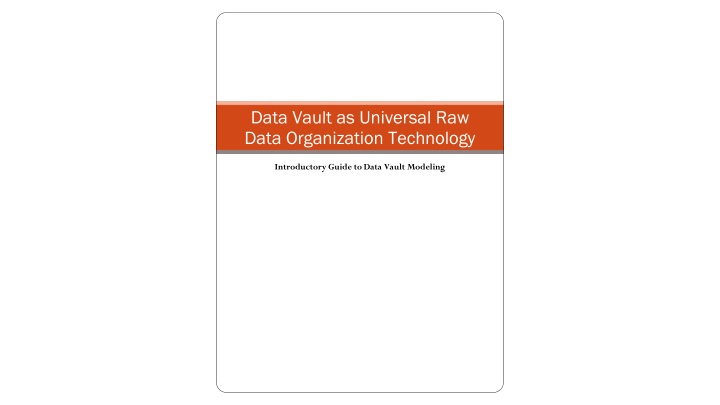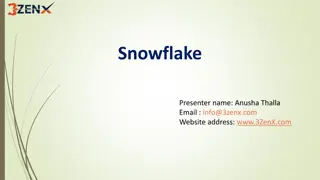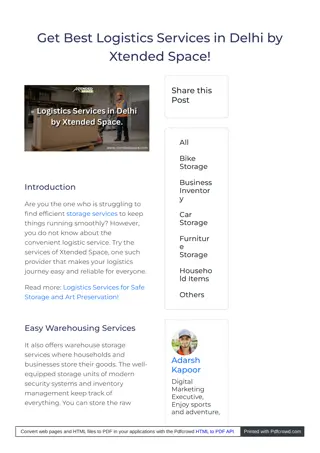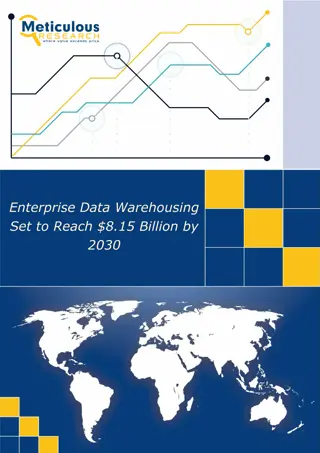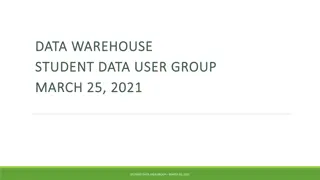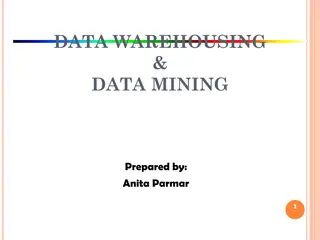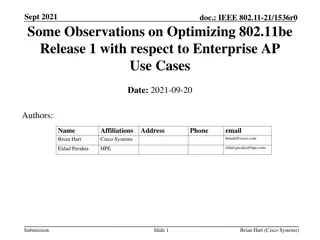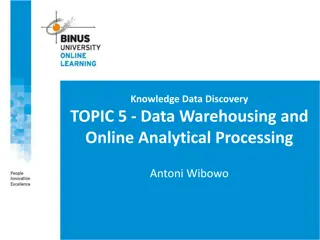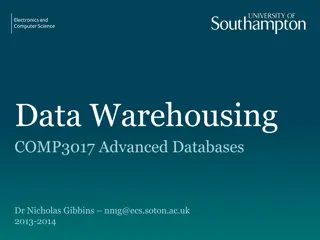Introduction to Data Vault Modeling for Enterprise Data Warehousing
Data Vault modeling is essential for implementing an effective enterprise data warehouse program, offering benefits like auditability, agility, and alignment with business needs. The model comprises core components such as Hubs, Links, and Satellites, each serving a specific purpose in organizing raw data for the EDW. Understanding these components is vital for building a successful data warehouse program.
Download Presentation

Please find below an Image/Link to download the presentation.
The content on the website is provided AS IS for your information and personal use only. It may not be sold, licensed, or shared on other websites without obtaining consent from the author.If you encounter any issues during the download, it is possible that the publisher has removed the file from their server.
You are allowed to download the files provided on this website for personal or commercial use, subject to the condition that they are used lawfully. All files are the property of their respective owners.
The content on the website is provided AS IS for your information and personal use only. It may not be sold, licensed, or shared on other websites without obtaining consent from the author.
E N D
Presentation Transcript
Data Vault as Universal Raw Data Organization Technology Introductory Guide to Data Vault Modeling
Data Vault as Universal Raw Data Organization Technology Data Vault as Universal Raw Data Organization Technology Introductory Guide to Data Vault Modeling Forward Forward Data Vault modeling is most compelling when applied to an enterprise data warehouse program (EDW). Several key decisions concerning the type of program, related projects, and the scope of the broader initiative are then answered by this designation. In short, the organization contemplating thisinitiative is committingto an integrated, non-volatile, time variant and business key drivendata warehouse program. The data vault principles are specifically well suited for such a program and when applied consistently can provide the organization with some very compelling benefits. These include auditability, agility, adaptability, alignment with the business, and support for operational data warehousing initiatives. To gain these benefits however, the organization will need to commit to both EDW program level factors as well as specific data vault modeling patterns, rules and methods. This guide presents data vault modeling in the context of the EDW. 1
The The Data Data Vault Vault Fundamentals Fundamentals The data vault consists of three core components, the Hub, other DV Program rules and factors, the commitment to the consistency and integrity of these constructs is paramount to a successful DV Program. Hub, Link Link and Satellite Satellite. Above all The Hub Hub represents a Core Business Concept such as Customer, Vendor, Sale or Product. The Hub table is formed around the Business Key of this concept and is established thefirst time a new instance of that business key is introduced to the EDW. It may require a multiple part key to assure an enterprise wide unique key however the cardinality of the Hub must be 1:1 with a single instance of the business concept. The Hub contains no descriptive information and contains no FKs. The Hub consists of the business key only, with a warehouse machinesequence id, a load date/time stamp and a record source. Fig. 1 Hub Hub A Link Link represents a natural business relationships between business keys and is established the first time this new unique association is presented to the EDW. It can represent an association between several Hubs and sometimes other Links. It does maintain a 1:1 relationship with the unique and specific business defined association between that set of keys. Just like the Hub, it contains no descriptive information. The Link consists of the sequence ids from the Hubs and Links that it is relating only, with a warehouse machinesequence id, a load date/time stamp and a record source. Fig. 2 Link Link Notice the similarity between the Hub and the Link. Both represent the first time a core business concept (Hub) or natural business relationship (Link) isintroduced to the DW.
The Satellite Satellitecontainsthe descriptive information (context) for a business key. There can be several Satellites used to describe a single business key (or association of keys) however a Satellite can only describe one key (Hub or a Link). There is a good amount of flexibility afforded the modelers in how they design and build Satellites. Common approaches include using the subject area, rate of change, source system, or type of data to split out context and design the Satellites. The Satellite is keyed by the sequence id from the Hub or Link to which it is attached plusthe date/time stamp to form a two part key. Note that the Satellite then is the only construct that manages time slice data (data warehouse historical tracking of values over time). Fig. 3 Satellite Satellite A Satellite does not have a Sequence ID of its own and in fact cannot have a different key than the Hub or Linksequence to which it is attached. Further, a Satellite does not have any foreign key constraints (no snow-flaking,branchingor bridging). These three constructs are the building blocks for the DV EDW. Together they can be used to represent all integrated data from the organization. The Hubs are the business keys, the Links represent all relationships and the Satellites provide all the context and changes over time. Fig. 4 Data Data Vault Vault Model Model 5
When we look at the Hub and Link together, they form the backbone of the model. This backbone model represents a 1:1 relationship with core Business Concepts and their natural business relationships. backbone or Skeletal Structure Fig. 5 Backbone Backbone or or Skeletal Skeletal Structure Structure Note that all all context context(descriptiveinformation)and all all history history arefound in the Satellites. M Mo od de el li in ng g w wi it th h t th he e D Da at ta a V Va au ul lt t The process of modelingwith the Data Vault is closely aligned with business analysis. The first step is to identify the Hubs for the given subject area. Once the Hubs are defined we next model the natural business relationshipsbetween these Hubs. Then we design and add the Satellitesto provide context to these constructs. STEP STEP TASK TASK 1.1 IdentifyBusinessConcepts 1.2 EstablishEWBK for Hubs 1.3 M Mo od de el lH Hu ub bs s 2.1 IdentifyNaturalBusinessRelationships 2.2 Analyze Relationships Unitof Work 2.3 M Mo od de el lL Li in nk ks s 3.1 GatherContext Attributesto DefineKeys 3.2 EstablishCriteria & DesignSatellites 3.3 M Mo od de el lS Sa at te el lli lit te es s Fig. 6 Steps Steps to to modeling modeling with with Data Data Vault Vault This process is not concerned with separating facts from dimensions, or from separating master entities from events or transactions. The focus is squarely on core business
concepts and their unique business keys. In that regard, all of the above are candidates for Hubs. For example events includingtransactions are modeled as Hubs. Think Think Differently Differently Modeling with Data Vault requires us to think differently. Most of us first learned 3NF modeling for operational databases. To manage third normal form, all attributes in an Entity must depend directly on the key of that Entity. So the context attributes that describe a customer (last name, first name, address, city, state, postal code, home_phone, mobile_phone, etc.) must be placed in the Customer Entity where the key uniquelyidentifiesan instance of a customer. If we included attributes that do not depend on the key of that entity then we would not be in 3rd normal form. Likewise if we placed some of the attributes that depend on that key into another entity then again we would no longer be in 3rdnormal form. At some point we may have also learned how to model using dimensional modeling techniques. Though different modeling constructs and other rules for modeling, the concept of including context attributes inside a table with a key for those attributes remains the same. A Conformed Dimension requires that context attributesdepend on the key of that Dimension. Again if we move out attributes depending on a dimension key to some other construct then we no longer have a conformed dimension. Shown here is a Customer_Entity in 3NF where we can see the Business Key (Customer_Code), the relationship (Customer_Class_SID) and all the context in the form of all remaining attributes in the table. Notice that this is one table including allof this these components. Fig. 7 3NF 3NF Customer Customer WithData Vaultmodelingwe separate the business keys from the relationships from the context. All of the business keys are modeled as Hubs, all relationships and associations are modeled as Links,and all context and history is provided for through the Satellites. Shown here we can see that the Business Key (Customer_Code) is in a Hub (H_Customer), the relationship (Customer_Class_ID) is in a Link (L_Customer_Cust_Class), and the context is modeledin several Satellites. Fig. 8 Data Data Vault Vault Customer Customer
Look back to the 3NF model and now consider that all of the same information (the same components of data) about Customer are represented fully in both models. Interestingly both models represent a dependency on a single business key. Actually if we draw circles around each of these models we can see that what is inside each circle is a representation of the same single business key, the same set of attributes and the same relationship. Notice here that the reaching out from the Customer to the Customer Class is modeled through a relationship with a FK inside the3NF circle. The same is true for the DV circle inthat reaching outfrom Customer to Customer Class is modeled though a relationship (Link) with a FK in that Link and on the perimeter of the circle. Fig. 9 3NF 3NF Model Model It is important to thinkof the DV circle in the same way as the 3NF circle. This means that a) allthings in either circle are dependenton a single business key, b) relationships pass through the circle directly from table with the BK, c) the only grain shiftin either circle is based on Date/Time stamp for the purpose of tracking history. Fig. 10 Data Data Vault Vault Model Model HINT: HINT: As you progress with Data Vault Modeling, this view of thinking differently will become more and more important. We tend to see tables the same way we have always see them. For this reason, we tend to re-combine keyswith relationships with context. But as soon as you do, you actually stop vaulting and return to other forms of modeling. So before you change the grain of a satellite, include a relationship FK in a Satellite or Hub, please consider the above circlesanalysis and reconsider.
The The Business Business Key Key At the core of the Data Vault is the Hub most important initial step in modeling a DV EDW is to identify and thoughtfully design these business keys. To begin with, a Business Key is representative of the core business entity like customer or product for example. Inaddition, the BK also represents event based keys such as sale or transfer . In thisway, the designprocess for the Data Vault does not concern itself with the differences between the person/place/thing typeentities and the event type entities. To put this another way, we are not concerned with differentiating Dimensions from Facts but rather are focusing on identifying Business Keys which can represent either. Hub which we refer to as the business key. Perhaps the This approach is then different from traditional approaches for modeling operational systems or data marts. The closest comparison would be to consider our efforts in defining Master Data elements for an MDM initiative. In this case as well, the focus is on the core terms used in managing the business. Since the DV Program is organizational in scope, the business keys should also strive to be meaningful across the enterprise. So our quest for these keys should result in Enterprise Wide Business Keys (EWBKs). Note also that the keys arriving from specific source systems are typically not fully aligned with these EWBKs. For this reason, we do not place too much emphasis on thekeys represented in any particular source system. NOTE: Since we are typically dealing with hundreds of sources, each commonly subject to updates and changes, we shouldnot planto modelour EDWusing keys driven by a subset of these source systems. The process of identifying and modeling these EWBKs is then closer to a business requirements gathering process than a source system analysis. Balancing the various input factors, with an emphasis on the business versus the technical, effectively summarizes the best practices for this process. Fig. 11 I In np pu ut tf fa act cto or rs sf fo or r d de es si ig gn ni in ng g t th he eD DV VE ED DW WB Bu us si in ne es ss sK Ke ey ys s 9
The primary inputsfor this process include: First First the business process designs, business interviews, existing data marts, business metadata, process metadata, a business glossary if is exists, semantic models, logical models, information models and the master data management artifacts (if existing) and the industry reference model (to the extent certain components are aligned) and then Second Second the technical designs, source databases, source metadata, application system (guides,manuals, designs) and actual source system data. Note that the EWBK should be a key that transcends time and withstands the replacement of any specific source system. The source system keys will then require some form of alignment to match up with their related target EWBKs. This alignment will often be at odds with the fully raw and auditable characteristics of persisted source system loads. In the past we have either resolved this alignment on the way to the marts, or more commonly, created a cleansed gold record within the four walls of the data warehouse itself. The former solution leads to silos and anomalies while the latter can compromise auditability and user acceptance. Business Business Key Key Alignment Alignment Because the DV EDW absorbs all data all of the time and maintains full traceability back to source system feeds, the data warehouse must not lose resolution on these auditable systems of record. At the same time integration around the business key the EWBK is a core function of the DV EDW. So the EDW today has a built-in challenge related to data integration the alignment of the Business Keys (enterprise-wide) with the Raw & Auditable components of the Data Vault. For the one side we know that we cannot rely on leaving the raw details only in the staging area or in our archives. We do need to have all data loaded into the EDW to be a true auditable mirror of the sources. See the bottom left Raw Keys infigure 5 below. Fig. 12 D DV V E ED DW WK Ke ey y Ali Alig gn nm me en nt t
On the other side we know that the enterprise data warehouse (EDW) must be aligned with the organizational view of the business keys/terms (EWBKs). See the top right Business Keys in figure 5. The integration of these Raw keys with the EWBKs represents a core function of the EDW today. In effect, we have been boxed in by the upstream requirements (build a DW that includes all data at the atomic level and with full traceability) and the downstream requirements (align the Business Keys with the organization at the enterprise level using business terminology). NOTE: We cannot rely on having these transformations happeninthe Mart Stagingor Data Mart layersas a) the Mart Staging is not intended to be persisted and b)the Data Marts are departmental in scope (not Enterprise Wide). Not sharing this business key alignment through the EDW will result in a failure to integrate around the true business keys and will result in the downstreaminconsistencies commonto data silos. The extent to which the sources are already aligned with the EWBKs will determine the scope of integration and alignmentthat must occur in the DVEDW. See figure 6 below. Fig. 13 DV DV EDW EDW Scope Scope of of Key Key Alignment Alignment The alignment of these keys is facilitated through Links previous page, the Raw Key of Person is aligned with the Business Key of Customer using a link structure. Links. As can be seen in figure 5 on the Note that the naming conventions are not adequate in and of themselves to warrant the separation of Raw and Business key Hubs. If in fact Person and Customer meant the exact same thing to the business and were in fact true business term synonyms, then the raw system load of Person records could populate the Customer Hub directly. However, in this case the Person Raw key does in fact mean something different than the Customer Business key. In this case we assume that there are business rules at play for example a Person record is determined to be a Customer if they were involved in a Sale transaction, there was a non-zero purchase price, the transaction was successfully completed, and the Sale was not cancelled. As youcan see here, the raw auditableload is to the Person and the business aligned load is to the Customer. Those tables that are loaded using this type of business processing must be identified as sysgen sysgen record source records (generated by us through a business rule driven process). 11
These components of the DV EDW are often referred to as business data warehouse (BDW) or business data vault (BDV) components. NOTE: Business logic in the BDW or BDV can take many forms and can relate to many types of transformations. The logicspecificallytargeting the alignment of rawand business keysis a subset of this area and often referred to as the BAR component (Business key Alignment Rules). Why is this important? Because the primary objective of the DV EDW is to integrate and historize data fromvarious sources. TheBAR rules are the heart of this activity. Both the BDW and the BAR layers are part of the business aligned data warehouse. Architecture Architecture The high level DV EDW architecture includes an EDW that aligns the RAWwith the BAR levels. Thehigh level architecture can berepresented as seen here. Fig. 14 DV DV EDW EDW Architecture Architecture Note that the business rules represented in the BDW layer can be applied either in the same area as the EDW or as a separate layer. Data Marts can then source the BDW and the EDW layers as appropriate. The Stage and Data Mart areas are not persisted. In a typical scenario, the Stage area is not persisted (data is not kept but rather overwritten). The EDW components are persisted, the BDW layer is commonly persisted however it is not required, and the Data Marts are not persisted. This latter point represents an important distinction between dimensional (federated) data warehouses and the DV data warehouse. Dimensional data warehouses are based on the concept of persisting the dimensions and associated facts. The RAW and BAR layers represent a logical designation. While this separation is often also physical, this factor is not required. In fact one common approach includes a logical separation with Links managingthe alignment within thephysicallayer.
Sample Sample Data Data Vault Vault Model Model 13 Fig. 15 Full Full Data Data Vault Vault Model Model
Hybrid Hybrid Tables Tables The data vault approach has defined a set of Hybrid tables that can be used to make the overall deploymentmore efficient. These are appliedon a case-by-case basis as appropriate for the specific circumstances. The Point PointIn In Time the satellites surrounding a particular Hub. This is populated to make the process of associating relative context/descriptive data together for reporting purposes. Timetable table(PIT) (PIT) isa modified Satellite table that tracks the valid time slices of The Bridge Bridge table includingimportant related context/descriptive data (potentially also thebusiness keys) into a single table for ease of access and performance. table is a modified Link stable that flattens the relationship between Hubs In all cases, these and other constructs can coexist in the DV EDW provided however that they are always noted as sysgen tables and utilized only for performance reasons. The related historical and auditable data that is used to load these constructs must remain the sole source of the EDW data over time. Applying Applying the the Data Data Vault Vault Data Vault modeling is uniquely useful when modeling a data warehouse. An Enterprise Data Warehouse (EDW) project is specifically well aligned with the features of data vault modeling. One primary benefit is the ability to adapt easily to changes in both upstream sources and downstream data mart requirements. This provides us the ability to build incrementally and to run a truly agile data warehouse program. The data vault data warehouse also easily integrates data and inherently manages history providing for a true enterprise data warehouse. Data Vault modelinghas also proven to be the preferred modeling pattern for special data warehouse situationsincluding truly operational data warehousing, Big Data integration, Information model based DW models, meta-data drivendata warehouse deployments and even data-driven generic data warehouse models. Understanding the full benefits of the data vault modeling approach starts with getting your certification. This process is facilitated by Genesee Academy and includes materials, online lectures, exercises, two days in a classroom with lectures, labs and group modeling exercises. On the last day there is an exam which results in the certified data vault data modeler (CDVDM) designation.
F Fi in na al l N No ot te e The Data Vault approach is growingand adaptingfrom year to year. Incremental changes to the modelingapproach, rules and best practices can be expected with some frequency. Please note that this guide should be applied in concert with current updates found online on data vault forums, LinkedIn and from certified practitioners.
